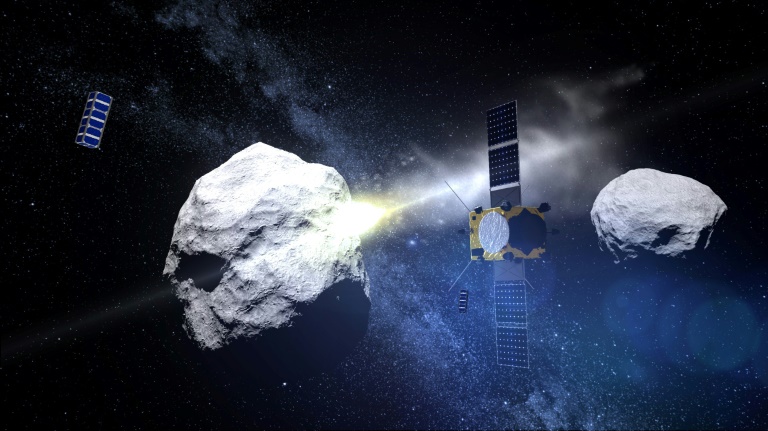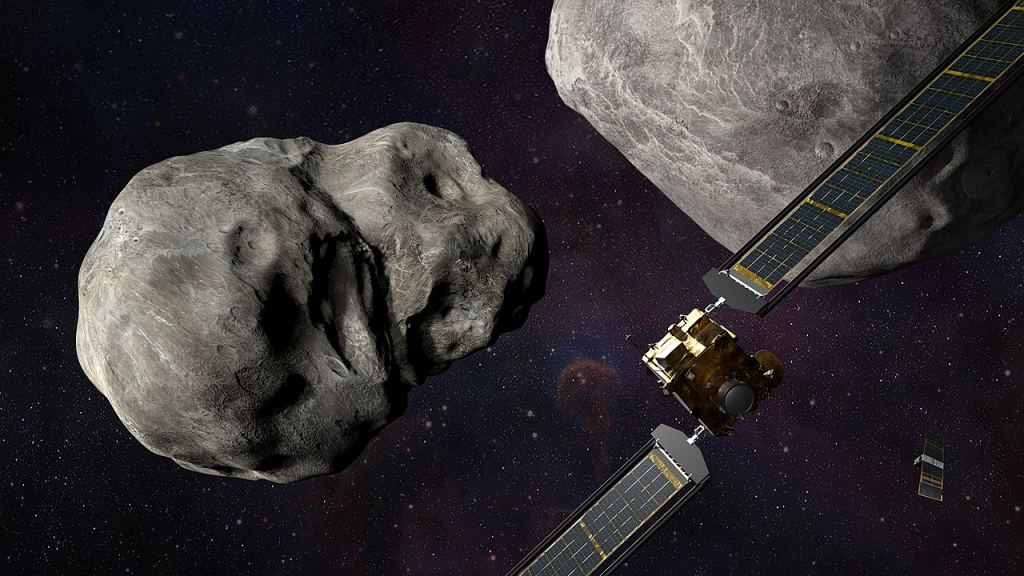On September 26th, 2022, NASA’s Double-Asteroid Redirect Test (DART) made history when it rendezvoused with the asteroid Didymos and impacted with its moonlet, Dimorphos. The purpose was to test the “Kinetic Impact” method, a means of defense against potentially-hazardous asteroids (PHAs) where a spacecraft collides with them to alter their trajectory. Based on follow-up observations, the test succeeded since DART managed to shorten Dimorphos’ orbit by 22 minutes. The impact also caused the moonlet to grow a visible tail!
However, as Hollywood loves to remind us, there are scenarios where a planet-killing asteroid gets very close to Earth before we could do anything to stop it. And there is no shortage of Near Earth Asteroids (NEAs) that could become potential threats someday. Hence why space agencies worldwide make it a habit of monitoring them and how close they pass to Earth. According to a new study by a group of satellite experts, it would be possible to build a rapid-response kinetic impactor mission that could rendezvous and deflect a PHA shortly before it collided with Earth.
The study, which recently appeared in Acta Astronautica, was conducted by Adalberto Domínguez, Víctor M. Moreno, and Francisco Cabral – three researchers affiliated with the Spanish satellite developer GMV. This company specializes in Guidance, Navigation, and Control (GNC) and Attitude Orbit Control Systems (AOCS) with commercial, military, research, and space exploration applications. For the sake of their paper, the research team presented GMV’s recent work on a GNC system for a Kinetic Impact mission.
 A computer-generated handout image released by the European Space Agency shows the impact of the DART (Double Asteroid Redirection Test) projectile on the binary asteroid system (65803) Didymos. Credit: ESA/AFP
A computer-generated handout image released by the European Space Agency shows the impact of the DART (Double Asteroid Redirection Test) projectile on the binary asteroid system (65803) Didymos. Credit: ESA/AFP
In recent years, space agencies have investigated multiple strategies for deflecting asteroids that pose a collision threat with Earth. As Domínguez explained to Universe Today via email, three are considered the most promising – nuclear standoff, gravity tractor, and the kinetic impactor. Whereas the nuclear option consists of detonating a nuclear device in the vicinity of an asteroid, the gravity tractor involves a ship flying around an asteroid to deviate its course. Only the kinetic impactor, said Dominguez, is feasible for deflecting PHAs:
“The applicability of the nuclear standoff is still to be demonstrated, and their target would be asteroids with a diameter in the order of several km. Those asteroids are not a threat nowadays, as the great majority are monitored. Moreover, the Outer Space Treaty of 1967 banned nuclear detonations in outer space. The gravity tractor targets more interesting asteroids in the order of hundreds of meters. There is a great percentage of asteroids of this size to be discovered, and the impact could imply the destruction of an entire city. Nevertheless, the gravity tractor would require several years to deviate this asteroid.”
For the sake of their study, Dominguez and his colleagues focused on developing a GNC system for a kinetic impactor. This is vital to any robotic mission, particularly where autonomy is called for. One of the most cutting-edge aspects of the DART mission was the autonomous guidance system it was testing, known as the Small-body Maneuvering Autonomous Real Time Navigation (SMART Nav). This system guided DART during its final approach to Dimorphos, as mission controllers could not issue course corrections at this point.
A KI mission designed to deflect an asteroid at the last minute will also require autonomy, mainly because of how fast it will travel. By the time it strikes the asteroid, the spacecraft will need a relative velocity of between 3 and 10 km/s – 10,800 km/h and 36,000 (6,710 and 22,370 mph). Said Dominguez:
“Another added difficulty is that we know barely anything about the asteroid we are targeting. This requires that the GNC must be adapted to any possibility. Moreover, the size of the asteroids implied introduces difficulties in navigation as we are talking of objects with a size of around one hundred meters. Imagine the difficulties associated with the problem of impacting an object with unknown dynamics and form, at a velocity of km/s and without the possibility of making any corrections from the ground.”
 Illustration of the DART spacecraft approaching the double-asteroids Didymos and Dimorphos. Credit: NASA
Illustration of the DART spacecraft approaching the double-asteroids Didymos and Dimorphos. Credit: NASA
This, says Dominguez, makes the GNC the most important critical subsystem element since it is in charge of targeting the asteroid and applying course corrections at the last second. These corrections have the added difficulty of being computed and executed in-situ – i.e., as the mission is rapidly unfolding. To ensure that their GNC design could execute such calculations, the team investigated algorithms commonly used by spacecraft (navigation, imaging processing, etc.) in their analysis and tested their performance. The former, said Dominguez, comes in two varieties:
“Guidance algorithms can be divided into two main groups: proportional navigation and predictive feedback. Proportional navigation algorithms use the knowledge of the current position of the target and the impactor to compute the maneuver needed to achieve impact. Proportional navigation is equivalent to the guidance employed by a missile, corrections are applied every second (continuous maneuvers) to correct the trajectory of the spacecraft.”
Meanwhile, predictive feedback guidance relies on past and present information to predict the future state of the spacecraft and impactor. In this case, corrections are only applied at certain moments in the mission, like when the spacecraft is just an hour away from performing the impact maneuver. Ultimately, they identified two main problems with proportional algorithms, which led them to incorporate predictive algorithms into their concept.
“Firstly, to be applied directly, it requires throttleable thrusters,” Dominguez said. “Secondly, it requires a system that allows constant maneuvers. These two facts generally imply a deterioration in fuel consumption and performance. With the employment of a predictive guidance scheme, the stress of the system can be noticeably reduced. Moreover, most of the current state of the art only employs proportional navigation. DART employed this kind of navigation scheme. We wanted to show that other approaches can also provide great results and could be employed.”
After simulating how these factors would affect a KI mission, the team found that their spacecraft was very accurate, with an impact error of just 40 meters (131 ft). According to asteroid monitors, an object that measures 35 meters (~115 ft) or more in diameter is considered a potential threat to a town or city. Meanwhile, the largest PHAs regularly tracked by NASA, the ESA, and other Earth defense organizations measure between 2 and 7 km (1.25 and 4.35 mi). Concerning the guidance system alone, their simulations achieved an error of less than one meter (~3.3 ft).
“This is a great result for the stage of development of our GNC concept, as we are considering errors greater than the ones that would be present in a real kinetic impactor, and the navigation could be noticeably optimized by improving the image processing and the filtering in order to increase the chances of a successful impact,” Dominguez concludes. “The scheme we proposed opens the door for the development of a kinetic impactor mission.”
In the future, he and his colleagues hope to optimize the variables of their kinetic impactor and compare its performance and applicability to other concepts. At the end of the day, it’s all about preparation, planning, and knowing that we have methods in place in the event of a worst-case scenario. While regular monitoring of Near-Earth Asteroids is the most important part of planetary defense, it’s good to have contingency plans in place. Someday, kinetic impact missions designed for long-range and last-minute intercepts could be the difference between Earth’s survival and an Extinction Level Event.
Further Reading: Acta Astronautica

